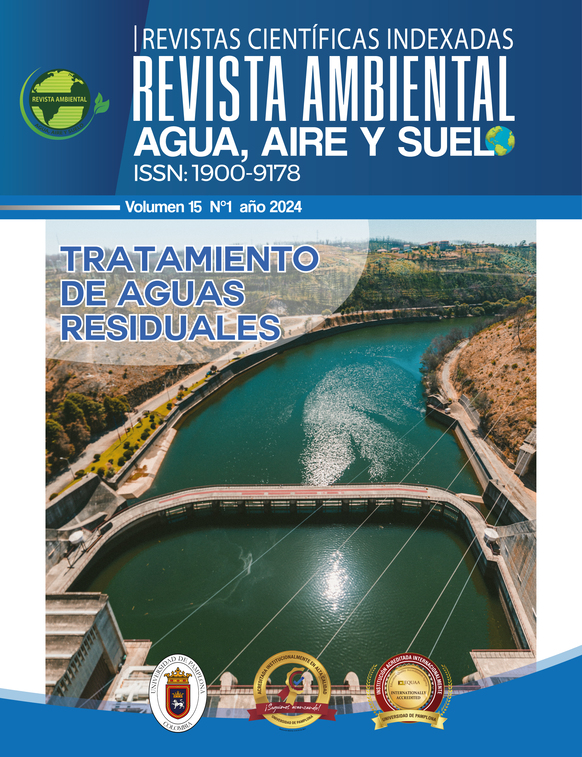Obtención de biocarbón como estrategia para el manejo sostenible de residuos derivados del proceso industrial de palma aceiteria (Elaeis Guineensis)
DOI:
https://doi.org/10.24054/raaas.v15i1.2915Palabras clave:
Pirolisis, biocarbón, sostenibilidad, palma de aceiteResumen
El desarrollo industrial en palma ha conducido a una mayor generación de residuos, por lo que esto se ha convertido en una problemática ambiental y económica. Por tal motivo, se implementó el método adecuado para la obtención del biocarbón a partir del raquis de palma aceitera. De esta manera, se realizó una investigación descriptiva, no experimental, en tres muestras de raquis homogeneizado de 500 gramos cada una, donde se les determinó: contenido de humedad del raquis, contenido de aceite del raquis, y rendimiento del biocarbón en base a materia seca. Se obtuvo una humedad promedio de 2,58 %, un contenido de aceite de 16,13 % y rendimientos en el biocarbón entre 76,96 y 79,24 %. Así, se evidencia que el método de obtención del biocarbón a partir del raquis de palma es satisfactorio, debido a los altos rendimientos alcanzados; generando mejor disposición de residuos al ofertar el biocarbón como fertilizante.
Descargas
Referencias
Anaya, A. (2018). Análisis de la eficiencia, pérdida total y costos para la optimización del proceso de extracción de aceite de palma en las empresas de la zona central palmera de Colombia (Trabajo de grado). Universidad Autónoma de Bucaramanga, Colombia.
Arias, F. (2012). El Proyecto de Investigación. Introducción a la metodología científica. Caracas: Editorial Episteme.
Cala, S. L., Yáñez, E.E., & García, J. A. (2011). Manual de procedimientos de laboratorio en plantas de beneficio. Colombia: CENIPALMA.
Guangasig, C. (2022). Obtención y caracterización de Biochar a partir de residuos de palma africana mediante pirólisis (Trabajo de grado). Universidad Central de Ecuador, Ecuador.
Jones, D.L., Murphy, D.V., Khalid, M., Ahmad, W., Edwards-Jones, G. & DeLuca, T.H. (2011). Short-term biochar-induced increase in soil CO2 release is both biotically and abiotically mediated. Soil Biology & Biochemistry, 43, 1723 - 1731. https://doi.org/10.1016/j.soilbio.2011.04.018.
Lehmann, J. & Joseph, S. (2009). Biochar for environmental management. UK-USA: Science and technology.
Leyva, S., Rodríguez, Y., Mendoza, T., & Cadena, J. (2019). Manejo del raquis generado en las extractoras de palma aceitera para la elaboración de compost. Revista científica ECOCIENCIA, 6 (4), 1- 17. https://revistas.ecotec.edu.ec/index.php/ecociencia/article/view/196/160.
Munar- Flórez, D.A., Ramírez-Contreras, N.E., & García- Núñez, J.A. (2022). Biocarbón como producto de la biomasa residual de palma de aceite en un concepto de economía circular. Boletín Técnico N°41. Colombia: CENIPALMA. https://publicaciones.fedepalma.org/index.php/ boletines/article/view/13709
Rosario, M., & Camacho, C. (2015). Apuntes de metodología de la investigación. Santa Bárbara de Zulia, Venezuela: Dirección de publicaciones UNESUR.
Slopiecka, K., Bartocci, P. & Fantozzi, F. (2011). Thermogravimetric analysis and Kinetic study of poplar wood pyrolysis. Applied Energy, 97, 491-497. https://doi.org/10.1016/j.apenergy.2011.12.056
Woittiez, L. S., van Wijk, M. T., Slingerland, M., van Noordwijk, M., & Giller, K. E. (2018). (2018). Brechas de rendimiento en el cultivo de palma de aceite: una revisión cuantitativa de factores determinantes. Revista Palmas, 39 (1), 16 - 68. https://publicaciones.fedepalma.org/index.php/palmas/article/view/12400
Descargas
Publicado
Número
Sección
Licencia
Derechos de autor 2024 REVISTA AMBIENTAL AGUA, AIRE Y SUELO

Esta obra está bajo una licencia internacional Creative Commons Atribución-NoComercial 4.0.










